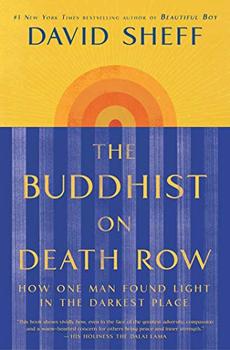Summary | Excerpt | Reviews | Beyond the Book | Read-Alikes | Genres & Themes | Author Bio

Critics' Opinion:
Readers' Opinion:
First Published:
Aug 2020, 272 pages
Paperback:
Jun 2021, 272 pages
 Book Reviewed by:
Book Reviewed by:
Valerie Morales
Buy This Book
This article relates to The Buddhist on Death Row
Jarvis Jay Masters was five years old when he was taken from his overwhelmed mother and placed with foster parents Mamie and Dennis Procks. They bestowed upon him the kind of luxuries middle class children take for granted. He had his own room, his own toys and clean clothes. His sheets were even ironed. More importantly, he wasn't neglected, abused or refused love. But when Mamie Procks became ill and could no longer care for him, he was moved. Again and again and again. While the Procks had extended love and mercy, kindness and laughter, goodness and warmth, his other foster families denied him food and beat him for small infractions. He ended up in juvenile lockup, where he was forced to fight, burned with cigarettes and sadistically whipped.
For children like Masters, who went through nine foster homes and three boys homes, experiences like these are not uncommon. The American foster care system was designed to be a temporary fix for troubled families, but neglect, abuse and a roulette of transitional placements are some of the systemic problems that Masters' story, with its sober realism, illuminates.
As of 2019, 440,000 children were in foster care in the United States. The average age that foster care begins is between 7 and 8 years old, and most children remain there for about two years, but 6% of foster children have been in care longer than five years, as Masters was. Only about 13% of foster children are adopted, while about 60% are returned to their parents and others age out of the system.
Due to the trauma of their situation, foster children can be angry, clinically depressed and broken-hearted. When they act out their feelings, overwhelmed foster parents may call the police. This type of situation frequently leads to juvenile lockup. Advocates have labeled this phenomenon the "foster care to prison pipeline." Once children who have been put in juvenile institutions age out of the system, they are often desperate and have nowhere to go. 40–50% of foster youth are homeless 18 months after leaving care. This only further leads to and normalizes criminal actions. Masters, for example, began committing armed robberies and hid out at his sister's house before the police arrested him. His story is a compelling and realistic look at what not having a safety net really means.
Additional statistics show to what degree the transitional nature of foster care can lead to a troubled adult life. 80% of inmates on death row were once in foster care. 60% of those who are human trafficked were once in foster care. 97% of foster care youth never receive a college degree. Considering that around 0.6% of children in the U.S. are currently in foster care, these lifelong effects are not just individually significant but significant on a larger scale. As the U.S. spends $31,000 per prison inmate every year, making the cost of lifetime incarceration for one person well over $1 million, it would make both moral and financial sense to evaluate how resources are being prioritized between the foster care and prison systems.
Some efforts have been made to improve the U.S. foster care system. For example, in 2004, the Pew Commission on Children in Foster Care recommended changes to reform policy in the system, asking for judicial accountability on behalf of children who are abused or neglected. In passing the Deficit Reduction Act in 2005, Congress invested $100 million to help track cases and prioritize systemic abuses. Another piece of legislation that incorporated Pew Commission recommendations was the Fostering Connections to Success and Increasing Adoptions Act, which was signed into law in 2008. However, additional improvement is still necessary, both in terms of legal protections for children and financial investment.
One positive model for foster care is Therapeutic Fostering in the United Kingdom. In Therapeutic Fostering, it is the responsibility of the foster parents to establish nurturing communication and be the child's ally, and parents are trained to support angry, withdrawn and traumatized children. Placing the focus on mediation, patience and a workable plan for conflict resolution is likely to create more positive outcomes than involving the police.
In addition to improving foster parenting, the U.S. system also needs to invest in its youth homes, which house 13% of foster care children. With many children being looked after in one facility, meeting all of their needs can be complicated and overwhelming for direct care workers, who may earn $13 per hour or less and are not necessarily given specialized education.
Of course, nurturing foster parents do exist in the current system, and in some cases foster children are adopted by loving and supportive families. For example, Amy and Michael Morris adopted the sibling group of seven they were fostering. The Morrises then fostered an additional sibling group of five. In 2019, Amy and Michael were Utah's Foster Mother and Father of the Year. The Morrises are proof that the system isn't entirely bleak. But as Masters' heartbreaking childhood illustrates, for every compassionate and generous foster parent, there are numerous abuses enabled by institutional problems. These abuses, though complex and enabled by political red tape, have to be addressed if we want to help neglected and maltreated children.
Filed under Society and Politics
![]() This "beyond the book article" relates to The Buddhist on Death Row. It originally ran in September 2020 and has been updated for the
June 2021 paperback edition.
Go to magazine.
This "beyond the book article" relates to The Buddhist on Death Row. It originally ran in September 2020 and has been updated for the
June 2021 paperback edition.
Go to magazine.




There is no science without fancy and no art without fact
Click Here to find out who said this, as well as discovering other famous literary quotes!
Your guide toexceptional books
BookBrowse seeks out and recommends the best in contemporary fiction and nonfiction—books that not only engage and entertain but also deepen our understanding of ourselves and the world around us.